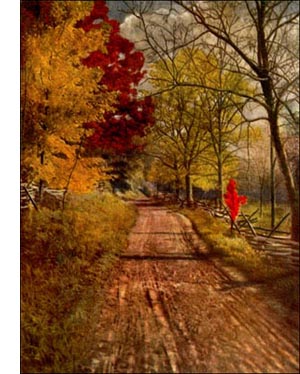Green Ash Tree
 Green Ash (Fraxinus lanceolata, Borkh.)-A handsome, round-headed tree, 50 to 60 feet high, with slender spreading branches and grey twigs. Bark, grey, furrowed, branches smooth. Wood heavy, hard, strong, brown, coarse grained, brittle. Buds rusty brown, very small, blunt.
Green Ash (Fraxinus lanceolata, Borkh.)-A handsome, round-headed tree, 50 to 60 feet high, with slender spreading branches and grey twigs. Bark, grey, furrowed, branches smooth. Wood heavy, hard, strong, brown, coarse grained, brittle. Buds rusty brown, very small, blunt. Leaves smooth, 5 to 9 leaflets on short stalks; ovate or lanceolate, acuminate at apex, sharply serrate, bright green on both sides, lustrous above. Flowers, April to May, before leaves, dioecious. Fruit in thick clusters, 1 1/2 inches long, oblanceolate, body round. Preferred habitat, rich soil on banks of streams.
Distribution, Lake Champlain to Florida; west to Utah, Arizona and Texas. Uses: A beautiful shade tree, especially adapted to the regions of scant rainfall. Lumber inferior to white ash, but used for the same purposes.
The green ash has its name from the dark, lustrous foliage which is intensified in its greenness by linings of the same colour, undimmed by any pubescence or pale bloom. The planter on the treeless stretches of Nebraska and Dakota loves this ash which grows with the commoner willow and cottonwood, where many trees utterly fail. A tree it is that not only lives but flourishes, showing that it suffers no homesick pangs for a greener land.
In the East, the green ash and the red are distinct enough, the latter having velvety, the former smooth, new shoots. In the western part of the Mississippi basin are ash trees that appear to be intermediate between the two species. Professor Sargent ranks the green ash as a variety of the red. Other authorities give it rank as a species; and it would not be surprising if further study of the intergrading forms would justify the tree student in making of these a distinct species, co-ordinate with the two older ones.
The most important thing, after all, about the green ash is that it is one of the agencies which is by degrees turning the Great American Desert into a land of shady roads and comfortable, protected homesteads. East of the Alleghanies the tree is little known. West of this range the tree is one among many shade trees where variety of planning is unlimited. In the West the tree comes into its own -and has few rivals. Here people have a sort of affectionate regard for it.